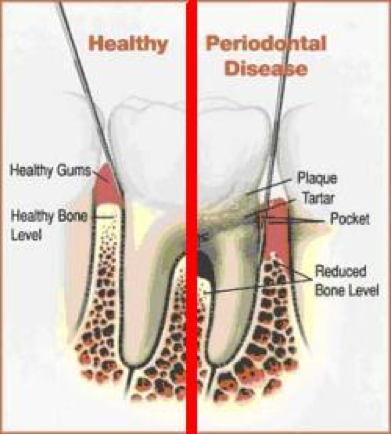Dental Implants are often the best treatment for missing teeth. When a damaged or decayed tooth is removed, both the visible part of the tooth, called the crown, and the root are lost.
A Dental Implant is placed in the jawbone so that it can fuse with your natural bone and become a strong and sturdy foundation for replacement teeth. Implants can be used to replace an individual tooth or for an implant-supported bridge or denture containing multiple teeth.
Of all the ways modern dentistry has to replace missing teeth, dental implants are by far the best. There is no tooth-replacement option that will give you a longer-lasting result. Implants also help preserve tooth-supporting bone that naturally deteriorates when a tooth is lost. Loss of bone is one of the major hidden consequences of losing teeth.

All-On-4™ is a revolutionary dental implant procedure that is considered to be the most advanced technology in the field today. The name is based on the fact that a full set of upper and/or lower replacement teeth can be affixed permanently in a patient’s mouth, anchored by only four dental implants. Unlike dentures, which have to be removed for cleaning and can feel loose and uncomfortable, All-on-4™ dental implants are permanent and come as close to feeling like your real teeth as possible. Once the procedure is complete, the patient has an immediate, functional set of permanent teeth with a beautiful esthetic appearance.
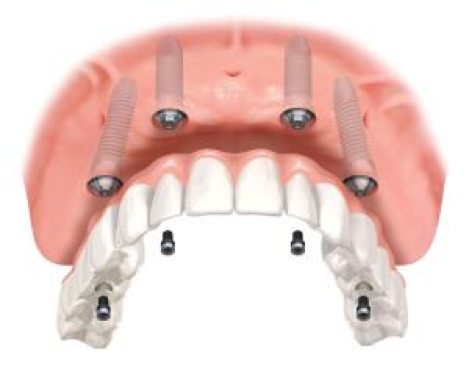
A Sinus Lift is performed in order to prepare a site for a dental implant in the upper jaw. Sometimes, when a patient has elected to have a dental implant, it may be necessary to have a sinus graft performed prior to insertion of the implant.
There may be a number of reasons why patients will have to undergo a sinus lift procedure. It could be that there are anatomical structures, such as the patient having a small jaw, or a large sinus, or a combination of the two resulting in little room for implant insertion.
When the sinus graft has been successfully completed Dr. Sirinian may insert the dental implants immediately.
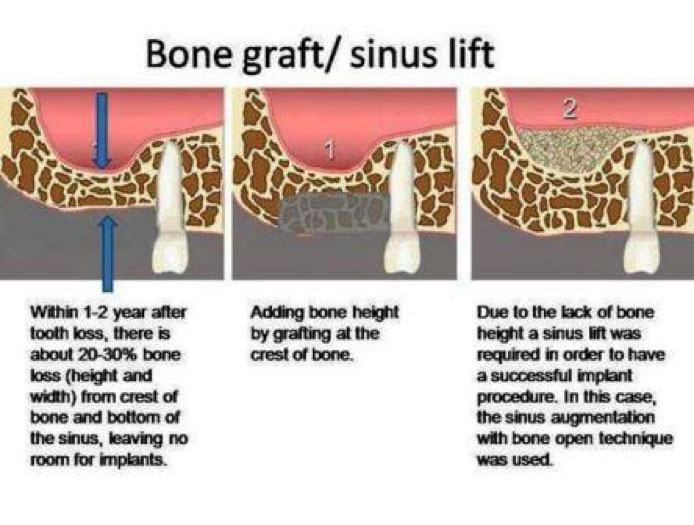
Potential implant candidates are frequently discounted because a lack of sufficient bone width. A ridge augmentation builds onto the bone, allowing it to support any number of dental implants after healing is complete.
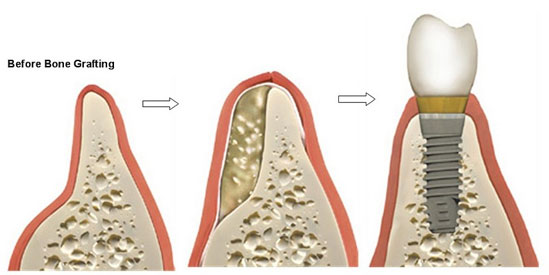
Dental extractions are performed for a variety of reasons, including tooth decay, injury, infection, and for orthodontic treatment.
When one or more teeth are extracted from the mouth, soft tissue and bone can begin to regress or collapse. Without the tooth root to stimulate it, the surrounding jaw bone will often begin to deteriorate shortly following the loss of a tooth. It is recommended to have a ridge preservation procedure performed at the time of an extraction, as it helps to promote the esthetics of the ridge and avoid defects.
Site preservation begins with the removal of the tooth. Dr. Sirinian will perform the extraction carefully so as to not disturb existing bone in the socket. Next, the doctor will place a specialized bone grafting product. The bone grafting material is designed to replace bone and stimulate bone growth in the socket. After it has been placed, the grafting material will be stabilized with sutures and possibly a collagen membrane. Healing time is approximately three to five months before a dental implant can be placed.
A Typical adult mouth has 32 teeth, though, most adults’ mouths can only accommodate 28 teeth. In many cases wisdom teeth fail to grow in at a proper angle, which can lead to complications. Improperly erupted wisdom teeth can push surrounding teeth out of alignment, harbor excessive amounts of bacteria, as well as cause pain and discomfort.
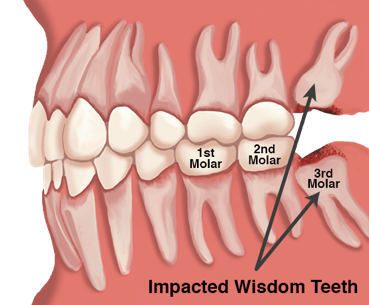
Sedation dentistry helps to provide a relaxing and calming experience for patients afraid of going to the dentist. We can administer sedation in a variety of ways. Regardless of the type of sedation you choose, the goal remains the same: to make your experience as pleasant as possible, and to be free of pain and worry.
Local Anesthesia – The most commonly used anesthesia in dentistry. Local anesthesia blocks the nerve signals involved in sending and receiving pain to a small, localized area and its surrounding tissues.
Oral Sedation – Administered without needles or intravenous tubes. Patients take a pill 30 minutes prior to their appointment. Allowing them to be completely relaxed before their procedure begins.
Intravenous (IV) Conscious Sedation – Administered through a vein, IV Sedation offers the deepest level of relaxation. Patient remain conscious, responsive, and fully in control to vital processes and in most cases their visit is not remembered.
Nitrous Oxide (N2O) – Also known as ‘laughing gas.’ Nitrous oxide is delivered using a face mask and provides a pleasant, euphoric feeling helping patients to relax during treatment.
As periodontal disease progresses, pockets of degenerated bone develop in the jaw. These pockets can promote the growth of bacteria and the spread of infection. To address these pockets Osseous and Tissue regeneration is the recommended. During this procedure, the pockets are cleaned thoroughly, and a membrane is installed between the soft tissue and the pocket in the bone. Some of these membranes are bio-absorbable and some require removal. The membrane covers the pocket so that fast-growing soft tissue is blocked, and slower-growing bone can begin to grow, or “regenerate” itself.

Gum recession is one of the symptoms of gum disease and occurs when the gum line moves up or down the root of the tooth. Gum recession can be limited to a single tooth or several teeth and has symptoms including root sensitivity, inflammation of the gum tissue, root exposure, root cavity formation, and aesthetic issues. If you do not have enough gum tissue around the teeth, bacteria can cause decay, gum and bone deterioration, or lead to tooth loss.
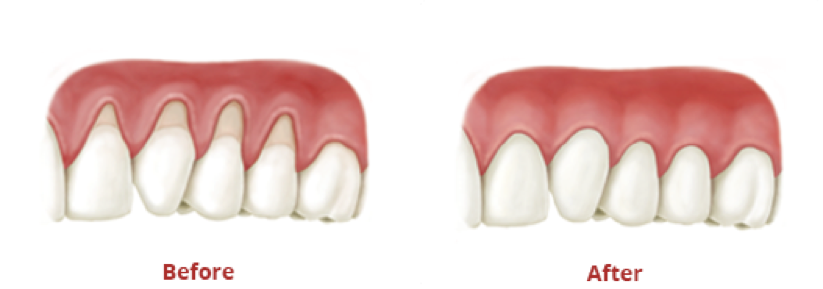
A gingivectomy is a periodontal procedure that eliminates excess gum tissue. The term “gingivectomy” is derived from Latin:
- “gingiva” means gum tissue,
- “-ectomy” means to remove.
The following are some reasons a gingivectomy might be needed:
Cosmetics: To make the teeth look normal in size when the gum is covering too much of it, making the teeth look longer and more proportional.
Functional/Esthetics: To remove excess gum tissue (gingival overgrowth) that has formed as a result of certain drugs such as anti-seizure and organ-transplant medications, and certain high blood pressure medications.
Bone and gum health around the teeth: To shrink deep gum pockets. This procedure might require some bone work as well.
Clinical crown lengthening will be needed in order to perform a cosmetic or restorative procedure. This may be the case if a tooth is too far decayed, broken below the gumline, or has insufficient structure for restoration like a crown or bridge. In cases like this, the gum and bone levels need to be lowered in order to expose more of the root surface so it can support a high quality restoration.
Sometimes teeth appear short, when they are actually the proper size but are covered with excessive gum tissue. This can be corrected by removing excess tissue to expose more of the tooth structure. The tissue can also be reshaped to allow for a more even gum line. The outcome is a more esthetically pleasing, natural-looking smile.
In some cases, reshaping the gum and supporting tissues provides your general dentist with adequate room to place quality final crowns or veneer restorations. Esthetic crown lengthening is critical and necessary in such cases in order to establish a natural looking smile when the front teeth are too short or uneven in length.
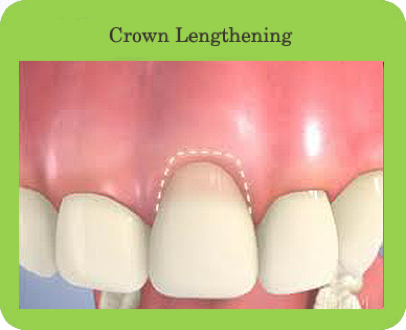
A Frenum is a naturally occurring muscle attachment, normally seen between the front teeth (either upper or lower). A lack of attached gingiva, in conjunction with a high frenum attachment can result in recession. An excessively large frenum can prevent teeth from coming together resulting in a gap between front teeth. In either case the frenum need to be released from the gum with a frenectomy.
When Orthodontic treatment is planned, the removal of an abnormal frenum, with or without a gingival graft, can increase stability and improve success of the final orthodontic result.
An impacted tooth simply means that it is stuck and cannot erupt into function. The maxillary canine is the second most common tooth to become impacted (wisdom teeth being the first). The canine tooth is a critical tooth in the dental arch and plays an important role in a patient’s bite.
The older the patient, the more likely an impacted canine will not erupt by natures forces alone even if the space is available for the tooth to fit in the dental arch. In these cases the impacted teeth will be exposed and bracketed with a temporary anchorage device.
Temporary Anchorage Devices (TADs) are devices which are temporarily implanted to the bone in order to enhance orthodontic anchorage by supporting the teeth of the reactive unit. Once in place the device is use to provide a fixed point of support for orthodontic braces. As your teeth shift position during the course of treatment, the temporary anchorage device will help ensure braces exert the proper force on the dental arch.
Oral pathology involves diagnosing and treating diseases of the mouth such as cysts, tumors, and precancerous and cancerous lesions. The inside of the mouth is normally lined with a special type of skin called mucosa, which is smooth and pink in color. Any alteration in this appearance could be a warning sign of a pathological process. These changes can be detected on the lips, cheeks, palate, and gum tissue around the teeth, tongue, face, and/or neck. Pain does not always occur with pathology and is often not associated with oral cancer. Diagnosing diseases in the mouth as early as possible is very important. The earlier a disease is diagnosed, the faster treatment and healing can begin.
Many people think that bleeding gums are just a result of brushing their teeth too aggressively. However, bleeding gums can be a symptom of a greater problem like periodontal disease. If you have painful or swollen gums, you could have a severe form of gum disease known as periodontal disease, an infection in your mouth caused by millions of bacteria that eat away your healthy tissue. If left untreated, periodontal disease eventually leads to tooth and bone loss.
The initial stage of treatment for periodontal disease is usually a thorough cleaning that may include scaling or root planing. The objective of this non-surgical procedure is to remove etiologic agents such as dental plaque and tartar, or calculus, which cause gingival inflammation and disease. Scaling and root planing can be used as a stand-alone treatment, or a preventative measure.

Gum disease is caused by the bacteria found in plaque. The toxins produced by these bacteria cause our bodies to destroy the bone that supports the teeth. If plaque is not removed, it can harden and form calculus (tartar) that can exacerbate the periodontal problem.
Flossing and brushing will help keep the calculus formation to a minimum, but regular maintenance is needed to professionally remove what has accumulated. During your maintenance cleaning, the hygienist will evaluate and record your periodontal pocket depths and check for hidden periodontal problems.
Maintenance visits to the periodontist can help prevent additional dental problems in the future, such as further bone and tooth loss. Treating the disease in its early stages can help save you from not only oral and overall health problems, but also money!
